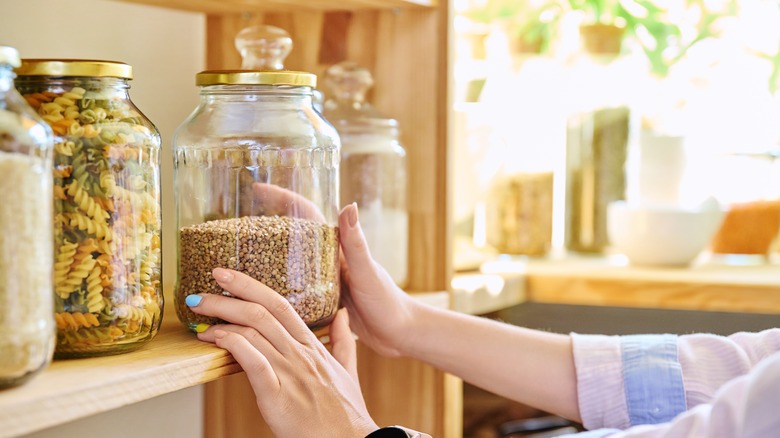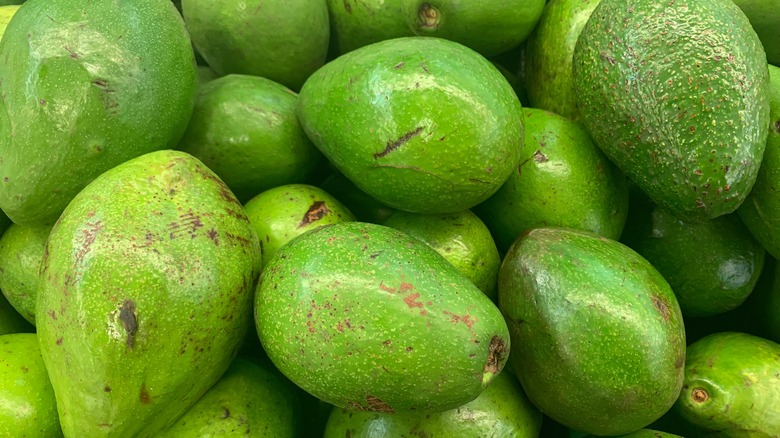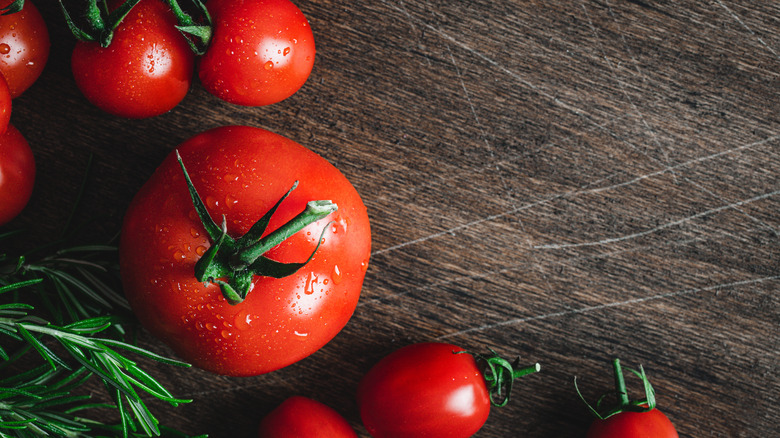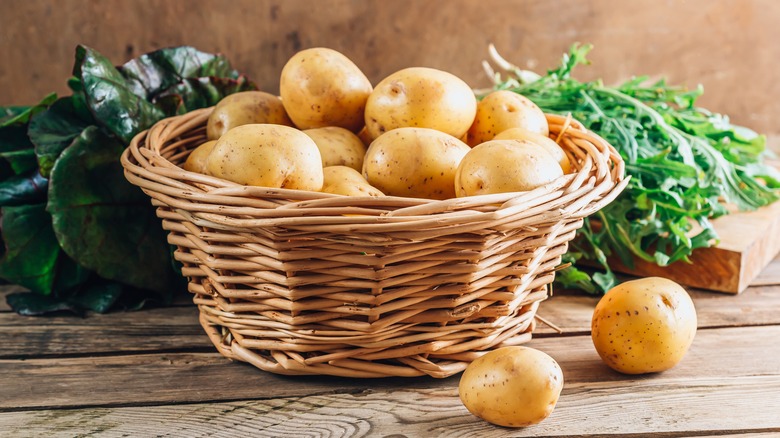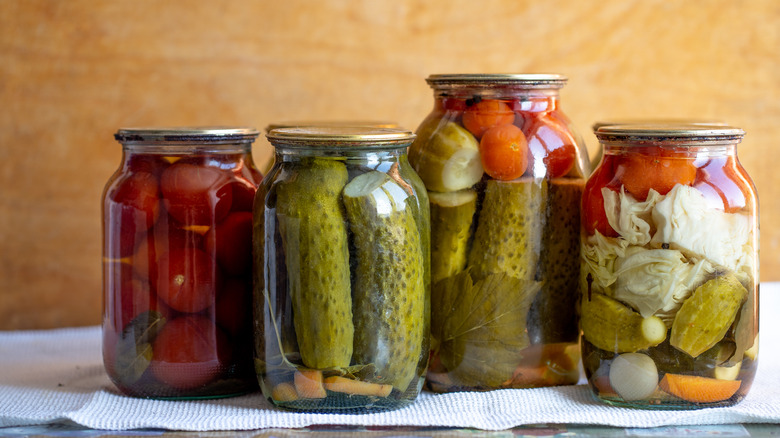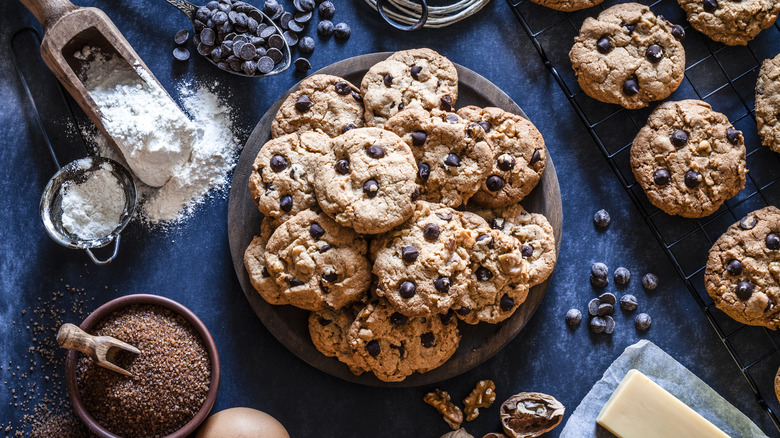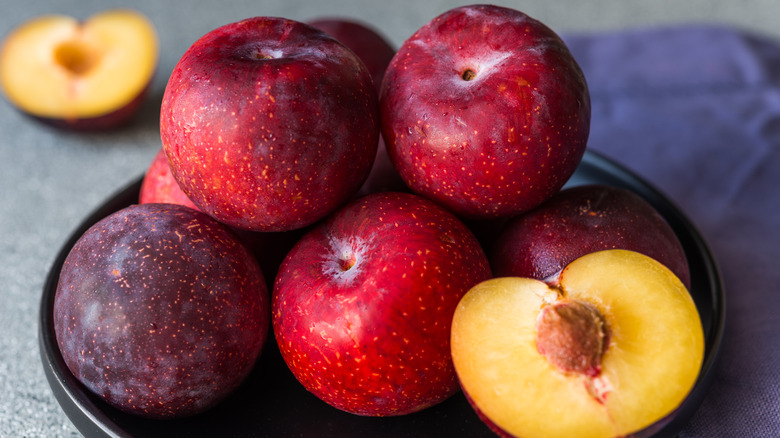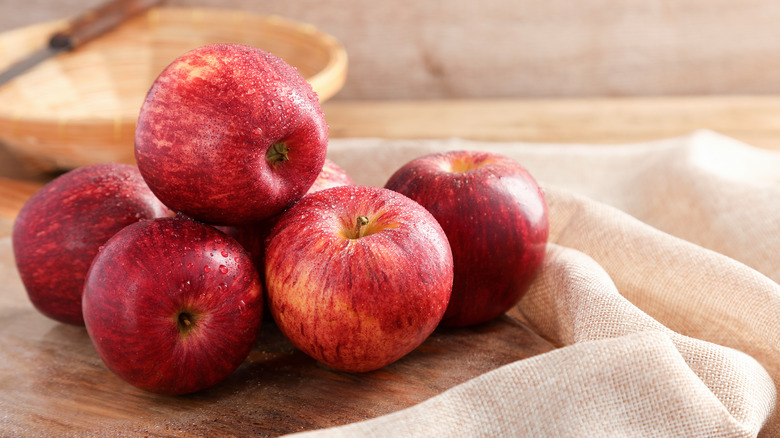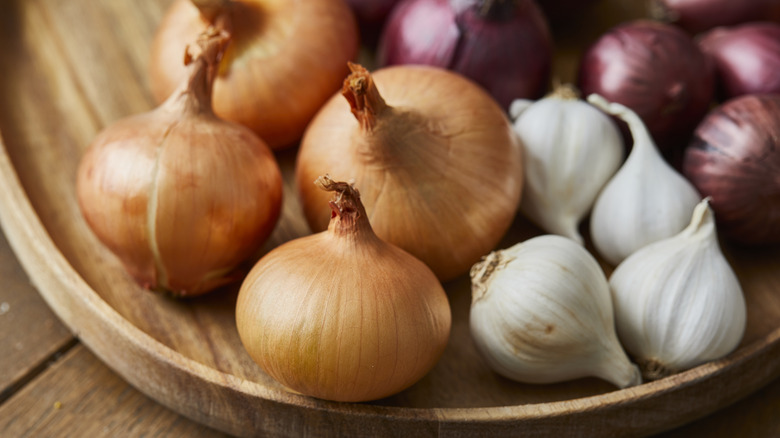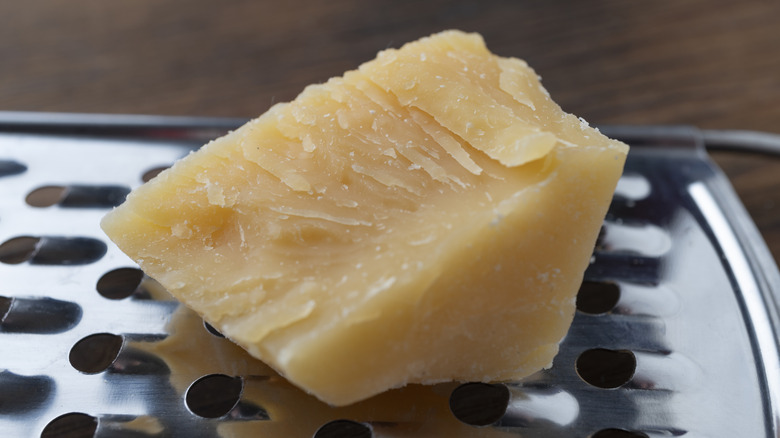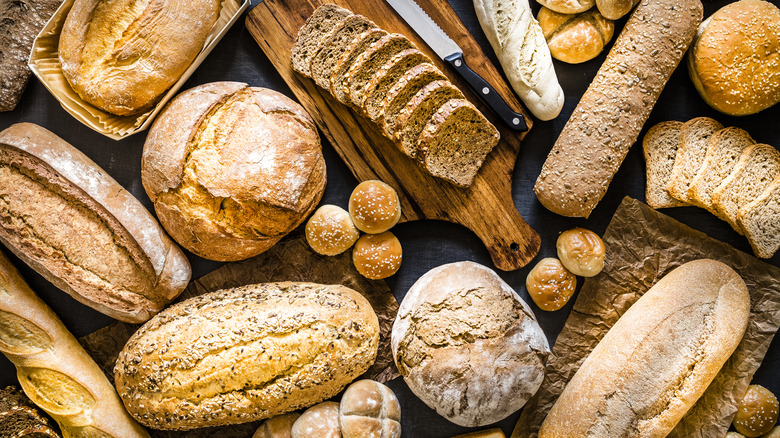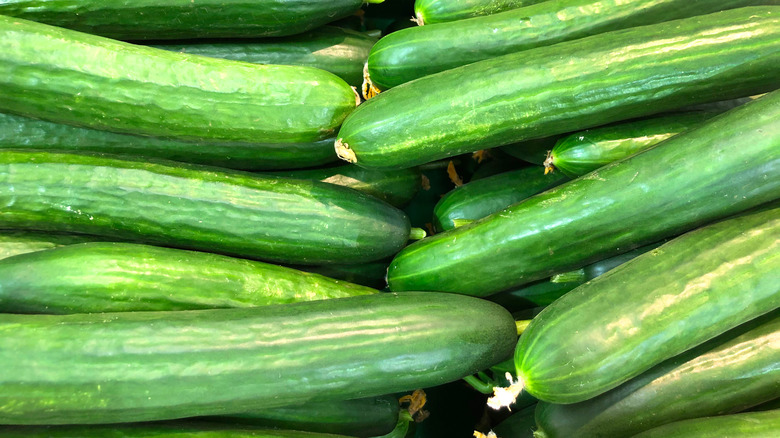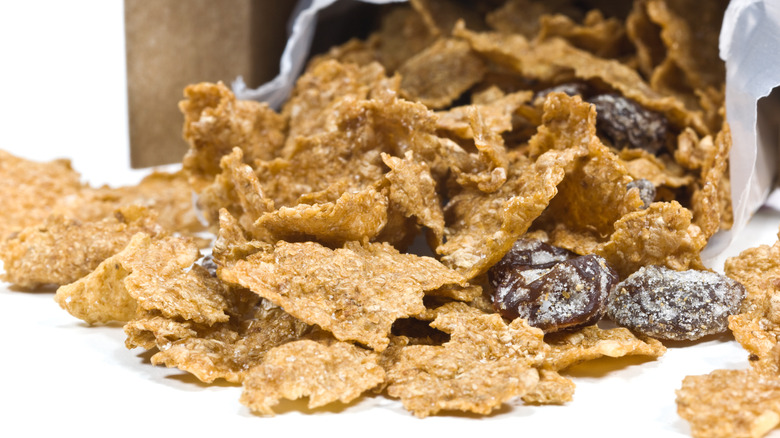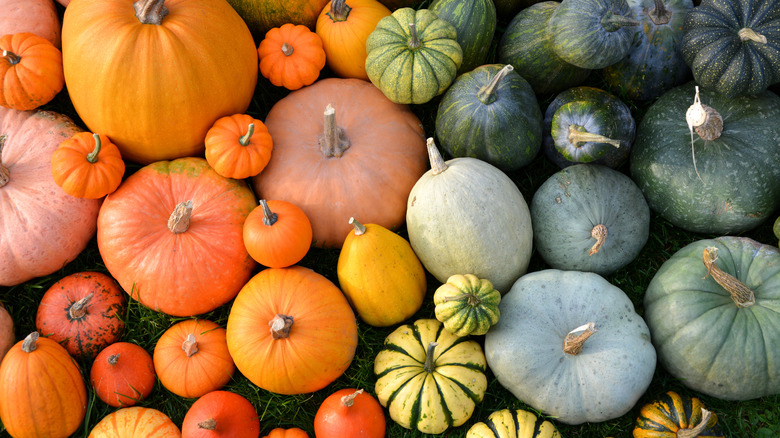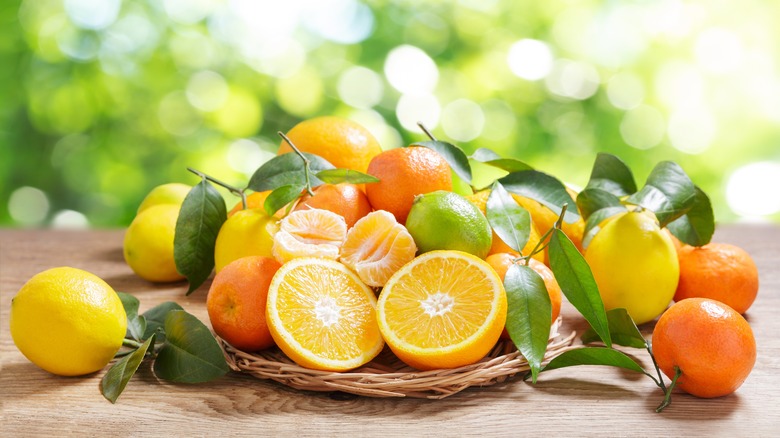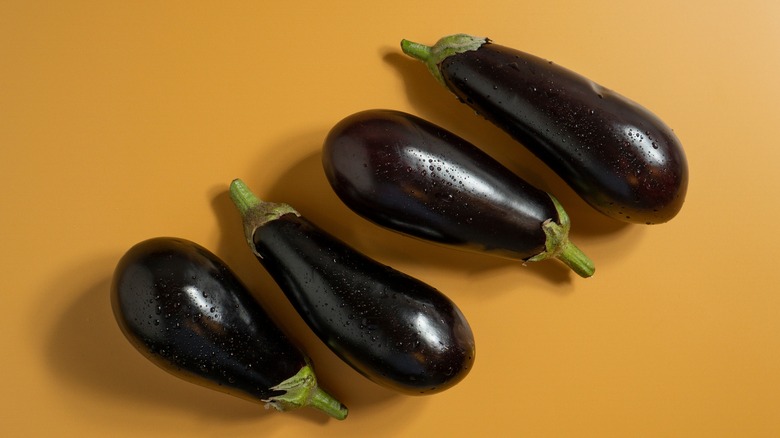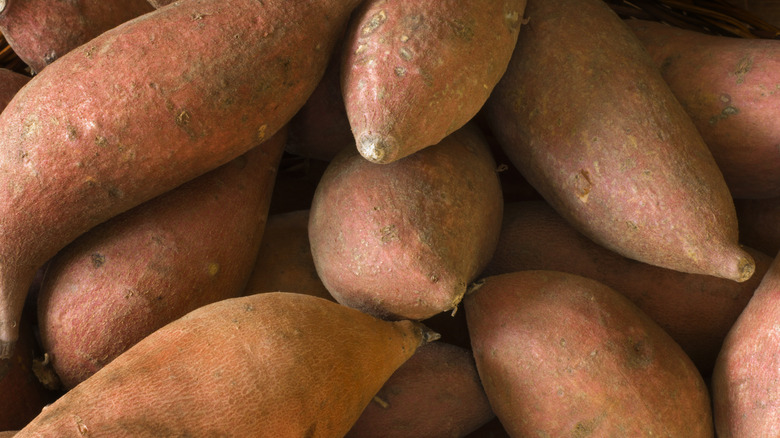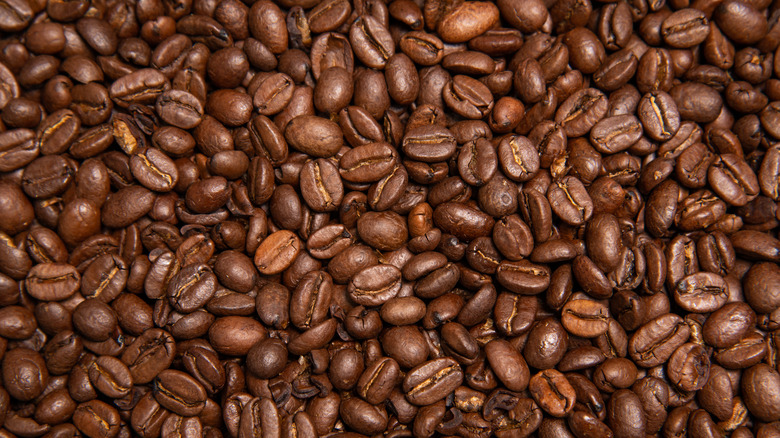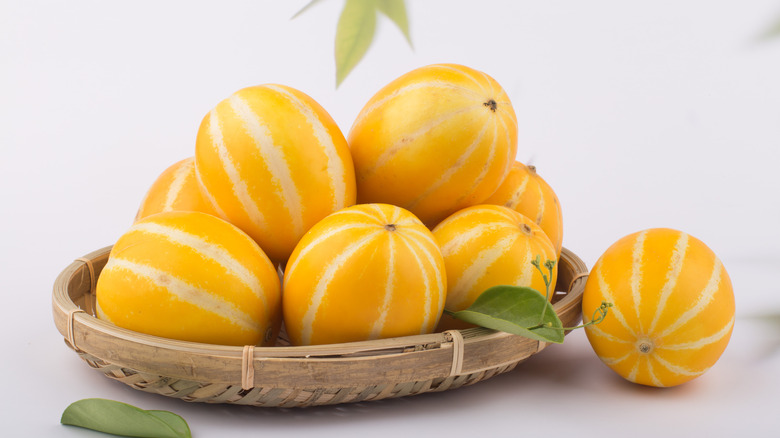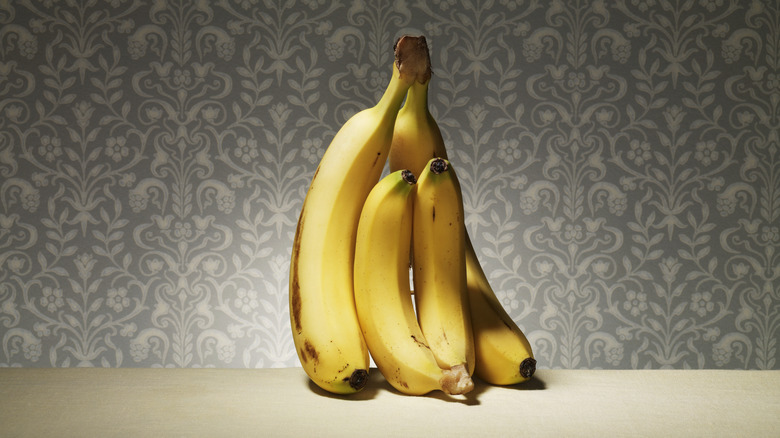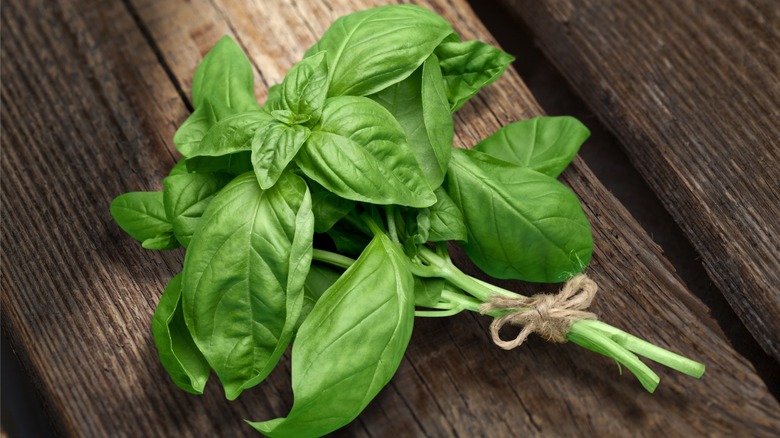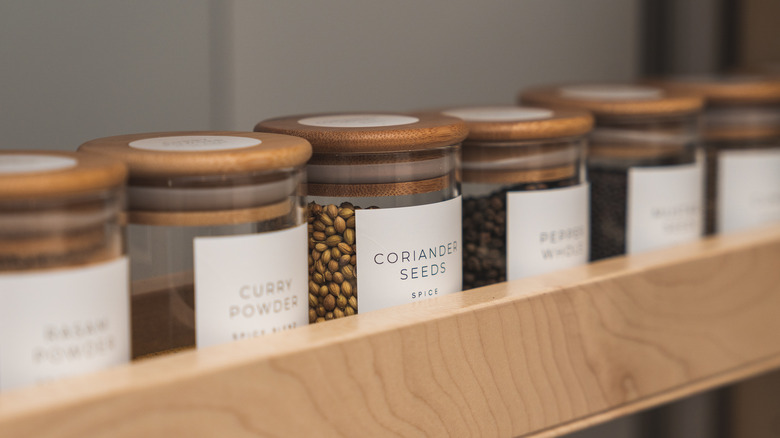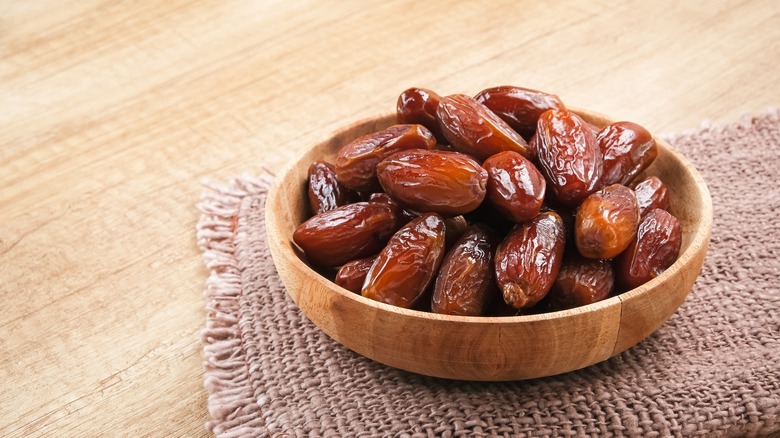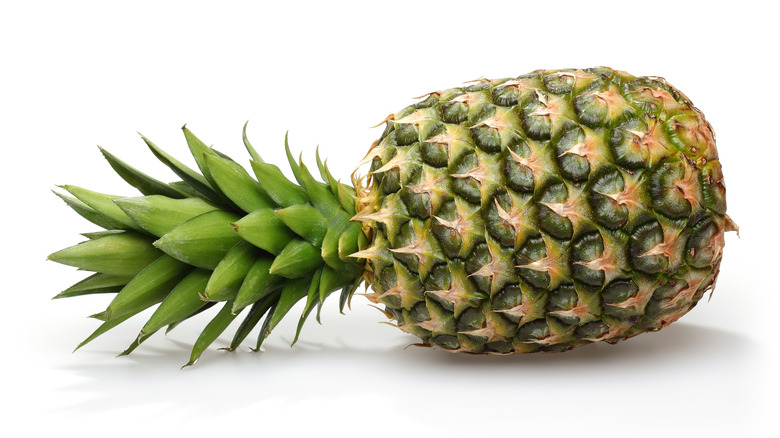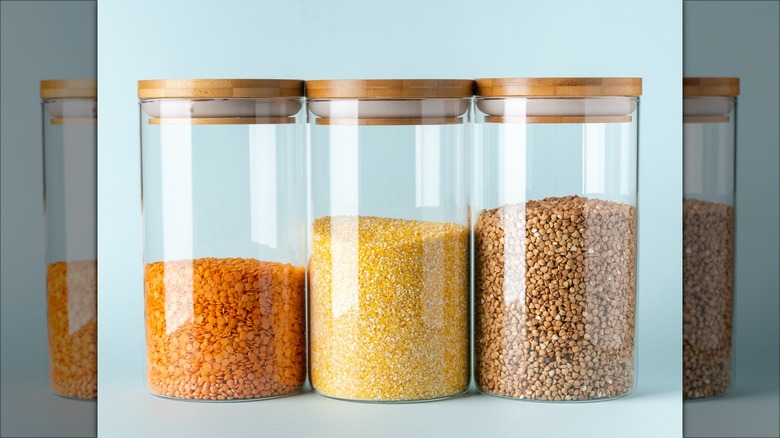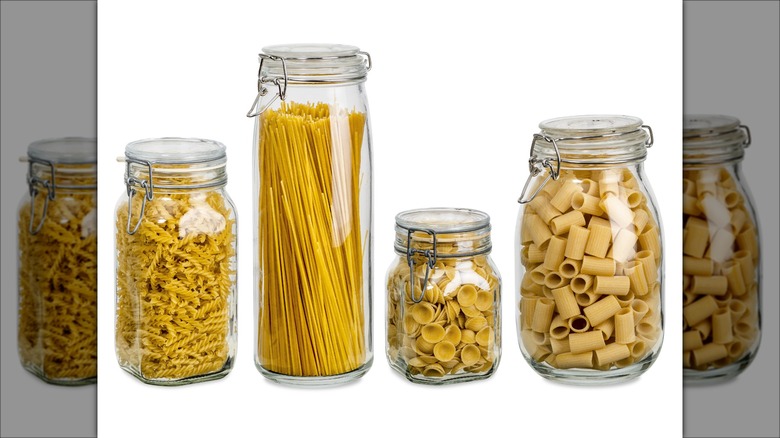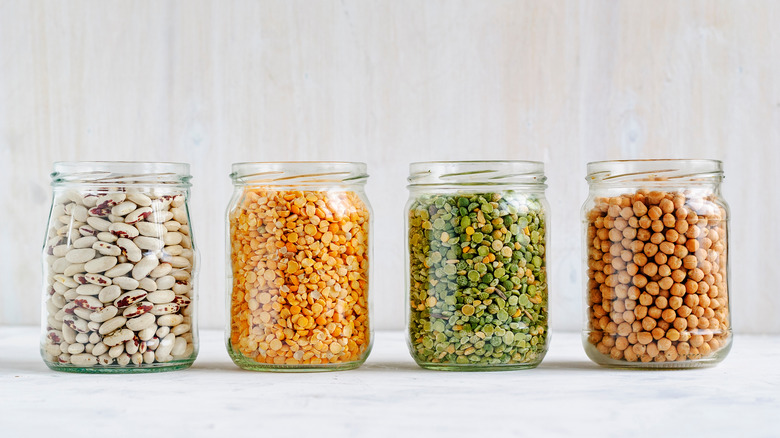28 Foods You Should Never Refrigerate And How To Store Them Instead
While the modern home electric refrigerator was not introduced until 1913 by American inventor Fred W. Wolf, humans have been using rudimentary methods of preserving food for centuries. The ability to refrigerate foods, thereby preventing the growth of pathogens and slowing the natural decomposition process, enabled humans to move away from a hunter-gatherer lifestyle to pursue other endeavors unrelated to survival.
Many foods absolutely must be refrigerated to ensure they can be consumed safely. Others, however, do not benefit from refrigeration and may suffer deleterious consequences in loss of flavor and texture. These foods can safely be stored in other ways that maintain their quality. That said, there are a few factors to consider with these foods. When you plan to consume something, whether it is raw or cooked, the degree of ripeness of a fruit or vegetable, and whether or not you have cut the food item all influence the need for refrigeration.
The following foods and beverages don't need to be refrigerated. We will look at why this is, when you should consider refrigeration, and how to store them instead. While you may have already known about some of these, we think you'll be surprised by several of them.
Unripe avocados
Avocados are notoriously precious tropical fruits that can go from hard as a rock to ready for the trash bin instantaneously. This is because these fruits are climacteric, meaning they will continue to ripen once harvested. Refrigerating a climacteric fruit or vegetable can halt the ripening process and damage its cellular structure, causing it to bruise and become mushy.
For this reason, it is best to allow your avocados to ripen on the countertop but keep them away from bananas and other produce that exude ethylene gasses, which can ripen your avocado before you are ready for it. An avocado should only be refrigerated if it is fully ripe and you don't plan to use it that day or have cut into it. To hasten the oxidation process, apply some lemon or lime juice to the exposed flesh of the avocado and wrap it tightly in a Ziploc bag before placing it in the refrigerator.
Tomatoes
Tomatoes, like avocados, are climacteric and will continue to ripen once harvested. They are also highly prone to what is known as cold injury, meaning if held for more than a day or two in temperatures below 50 degrees Fahrenheit, like in the refrigerator, they may become damaged, their texture rendered mealy, and their flavor muted.
The solution is to store under-ripe or barely ripe tomatoes on the countertop, stem-side down, and to consume them within a few days of harvest. Keeping them stem-side down will help maintain juiciness and allow them to ripen further. If you have sliced the tomato and do not consume all of it immediately, place the remaining portion in a Ziploc bag and refrigerate it. Improperly refrigerated cut tomatoes are a frequent culprit of salmonella outbreaks, so don't skip this step. You can revive some of the tomato flavor by bringing it to room temperature before eating it.
Potatoes
Root cellars exist for a reason. Root vegetables, like potatoes, have very distinct needs in terms of long-term storage, chief among these remaining cool, but not too cold, dry, and away from sunlight. Potatoes subjected to frigid, moist conditions, such as inside a refrigerator, will begin to rot, converting natural starches into sugar and sprouting.
For this reason, it is ideal to store potatoes in a pantry or basement and in an environment away from other fruits that may encourage the emission of ethylene gasses, like apples. Additionally, potatoes should be stored in a well-ventilated area where carbon dioxide won't build up and cause them to mold. And finally, potatoes should be kept away from ambient sunlight, which will encourage chlorophyll production and cause them to shrivel up. Once potatoes have been cooked, they should be stored in the refrigerator in an airtight container.
Unopened Pickles
Pickling vegetables is a marvelous way of preserving them for long-term storage. The acidic brine and proper heat canning process used for commercial and homemade pickles create an environment inhospitable to the proliferation of microbes. When safely canned, pickled vegetables can last for years in a cool, dry place in your pantry, away from sunlight, which can deteriorate the color and texture of your pickled vegetables.
The key is leaving them unopened. Signs to look out for that may suggest improper canning include the can or jar swelling, the brine bubbling, cloudy liquid, foul odor, or evidence of mold formation. If you notice these signs when you open the jar, you should immediately discard the pickles. Once you have opened the jar, transfer it to the refrigerator and store it like any other condiment. We recommend using tongs to remove pickled vegetables from their container to prevent cross-contamination.
Baked goods
If you are an avid baker, you will want to store your baked goods properly after all that measuring, mixing, waiting, and cleaning. Contrary to popular belief, unless your pastries, cookies, quickbreads, cakes, or brownies include raw dairy or eggs, like a cream cheese frosting or meringue, you should never refrigerate them. Placing baked goods in the refrigerator will dehydrate your sweet treats, turning them into a dry, crumbly mess.
It is best to store your baked goods in an airtight container on the countertop. More delicate baked goods, like cakes and pies, may begin to stale within a couple of days, while things like brownies and cookies can last up to a week. Some experts suggest taking a slice of bread and placing it inside the Ziploc bag or storage vessel of choice alongside your baked goods. Doing so will help encourage moisture retention, keeping your baked goods more tender.
Stone fruit
Stone fruits, or drupes, get their name from the pit, or stone, at the center of them. This family includes peaches, apricots, plums, nectarines, mangoes, cherries, and even olives. Many of these fruits are climacteric, which makes them highly susceptible to refrigeration.
It is recommended that these fruits be stored without being washed, stem side down, in a single layer, on a plate or baking sheet lined with paper towels at room temperature. This will encourage further ripening while maintaining ultimate sweetness and preserving the delicate texture of the peels of these fruits.
The one exception to this rule is cherries, which will not continue to ripen and begin to deteriorate immediately after harvest. These should always be kept in the refrigerator, unwashed, or in a container with adequate ventilation. Like other produce, once stone fruits have been cut, you should cover them with plastic wrap and refrigerate them.
Apples
Apples are another climacteric fruit that will continue emitting ethylene gas and ripening long after harvest. Apples are such prolific emitters of ethylene gasses they can easily contaminate other fruits. For this reason, they should never be stored alongside other fruits or vegetables. You should check your apples thoroughly for blemishes before storage. A single apple that has been compromised will tarnish the bunch, encouraging them to rot faster.
The ideal location for storing apples is a cooler, dry, adequately ventilated environment free of sunlight, like a pantry or basement. If you live in a humid climate, consider purchasing a dehumidifier for your pantry or kitchen to eliminate excess moisture. Once cut, apples quickly oxidize and can benefit from being acidulated to avoid browning before getting wrapped in plastic and refrigerated.
Onions, garlic, shallots
Alliums, like onions, garlic, and shallots, are unique in that they come with their protective covering in the form of layer upon layer of papery skin, which shields the delicate interior of these aromatics. The key to storing these is to eliminate any excess moisture that may permeate this external shell and place them in a cool place away from light. Additionally, never place alliums in a plastic bag or container, as lack of ventilation can trap moisture and ethylene gasses, causing more rapid deterioration. For this reason, they should never be stored alongside potatoes either, as they will quickly promote rotting in the potatoes.
Properly stored alliums can be kept for a couple of months. Once you have cut an onion, it should be placed in a Ziploc or other airtight container and refrigerated away from delicate foods that may easily take on their pungent aromas.
Hard aged cheese
According to the USDA, hard-aged cheeses, like parmesan, Pecorino Romano, cheddar, gouda, and processed cheeses, such as American cheese in unopened blocks or tubes, do not need to be refrigerated to be stored safely. Some of these cheeses may undergo irreparable damage to flavor and texture once exposed to the colder temperatures and moisture of refrigeration. These cheeses can be stored outside the refrigerator because they become dried out in the aging process, which makes them less hospitable environments for bacterial growth.
To safely store hard-aged cheeses, wrap them in wax paper or aluminum foil and set them in a cool, dry place, away from a heat source or sunlight, like a pantry. Some experts also recommend weekly vinegar treatments to remove potential contaminants and extend shelf-life. For processed cheeses, you should adhere to storage guidelines on the nutritional label of the cheese after opening the packaging.
Bread
Similarly to other baked goods, bread is a food that is best not left in the cold refrigerator. As the starches in bread are cooled, they will crystallize anew, causing the bread to become dehydrated, crumbly, and unpalatable. Even home-baked bread that lacks preservatives, if consumed within a few days, can and should be stored at room temperature, wrapped in plastic wrap at a moderate temperature, in a low-humidity environment that is not exposed to sunlight.
The only exception to this rule may be gluten-free bread, which is notoriously quick to spoil and should always be put in the refrigerator or freezer. If you cannot consume a store-bought loaf of bread within approximately a week, you should freeze some for later use. Be aware that doing so will impact its flavor and texture. Otherwise, skip the fridge and purchase a decorative bread box to store your loaf.
Cucumbers
Here is one that we didn't know either. Never refrigerate a cucumber. Doing so can cause cold injury. When exposed to temperatures below 50 degrees Fahrenheit, cucumbers develop soft pockmarks, get mealy, and their skins will begin to get mucilaginous. For best results, cucumbers should ideally be stored at room temperature, in a cool, dry place, away from sunlight or other heat sources.
But hold up, do not store your cucumbers near fruits or vegetables that are prolific producers of ethylene gasses, like apples, bananas, or melons. They are highly susceptible to deterioration from these fumes. Give them their own space that is well-ventilated in a bowl or basket. Once you have cut into a cucumber, you should encase it in a paper towel and place the remaining segment in a Ziploc bag or airtight container toward the opening of the refrigerator where it is warmest.
Cereal
Never store cereal in the refrigerator. It is highly susceptible to humidity, making your crispy rice a mushy mess. It can also absorb smells, like cut onions, which aren't particularly appealing. Once you have opened a cereal box, you should ideally transfer the contents to an airtight container, like a canister with a tightly sealed lid. This will ensure that not only is your cereal not getting exposed to moisture, but it will be safe from bugs.
You can reseal the original packaging using a chip clip if you plan to consume cereal within a week. Be sure to store the box or canister in a cool, dry place, away from sunlight. As with all dry goods, if you live in a humid climate, you may want to invest in a dehumidifier for your pantry to store these foods in an optimal environment.
Winter squash
Winter squash, like acorn, butternut, Hubbard, banana, buttercup, and pumpkins, is a fruit that has evolved with its shield of armor designed to protect it for long-term storage. Most of these types of squash, except acorns, must get cured before storage. This process involves allowing the squash to sit in the sun for seven to 14 days at temperatures between 80 and 85 degrees Fahrenheit, away from moisture. During this time, the natural respiration of the squash begins to decelerate, which enables the skin to harden into a dense protective shell.
Once cured, these squash will keep in a cool, dry, well-ventilated place away from sunlight for months. Always store squash off the floor and away from ethylene gas-producing fruits or vegetables, which may damage them. Squash that develops any blemishes should be separated from its peers so that it does not promote rotting of the whole crop.
Citrus fruits
Although citrus fruits are not climacteric, they are sensitive to extreme temperatures once harvested. If exposed to excess heat or sunlight, they can become acrid. Excessive cold, like the refrigerator, will impact the quality and nutritional value of the fruit. For this reason, it is recommended that citrus fruits, except limes, be kept at room temperature, away from sunlight, in a cool, dry place.
Those living in a high-humidity climate may need to invest in a dehumidifier to maintain lower moisture levels in the pantry or kitchen. Citrus fruits should be kept in a single layer rather than stacked on top of one another. Remove fruit from the batch at the first sign of deterioration to avoid contaminating the rest. The only citrus fruit that must be stored in the refrigerator is lime, which is more precious and susceptible to the elements.
Eggplant
This is another one that we intuited but didn't quite understand. We always wondered why a bright purple, firm-skinned eggplant would quickly become mushy, saggy, and brown-fleshed after a day or two stored in the refrigerator. Like its cousins in the nightshade family of plants, eggplants are susceptible to cold injury when kept below 50 degrees Fahrenheit for longer than three days.
The best way to store these violet-hued beauties is at room temperature in a well-ventilated place, away from sunlight. Remove them from plastic bags that can trap moisture, and never keep them near fruits or vegetables that are prolific ethylene gas producers, such as bananas and apples. You will be surprised at how much longer your eggplant will last when not subjected to the ravages of the cold.
Sweet potatoes
Sweet potatoes and potatoes may belong to different botanical families but are very much alike in their storage needs. Like potatoes, sweet potatoes are highly susceptible to the cold. When kept in the refrigerator, the cellular structure of a sweet potato can begin to degrade, making it mealy and destroying its delectable taste. For this reason, they should always be kept in a cool, dry, well-ventilated place, away from light and heat sources, such as the oven.
Never wash your sweet potatoes before storing them. Excess moisture can cause premature molding. While you may keep potatoes and sweet potatoes together, they should never be kitchen bed buddies with other ethylene-producing vegetables, particularly onions, which will make them turn green and sprout. The only time to refrigerate sweet potatoes is after cooking them.
Coffee beans
Though it may seem like a great idea to purchase a bulk bag of organic, fair-trade coffee beans at your local big box store, don't. Coffee is notoriously delicate and not designed for long-term storage. Coffee beans are hygroscopic or prone to wicking up moisture, making the refrigerator inhospitable as a storage environment. They also tend to oxidize rapidly, which causes their flavor to deteriorate from the moment they are ground.
Store whole beans in an airtight, nontransparent vessel with a tight-fitting lid to preserve the flavor and aroma. This will protect it from heat, oxygen, sunlight, and humidity. Place this canister in a cool place, like a cupboard or pantry, away from heat sources, like your oven or stove. If you are compelled to buy in bulk, you can freeze coffee beans for up to a month in an airtight container, but fresh is always best.
Whole Melons
Melons are a mixed bag. Some, like cantaloupe, are climacteric, while others, like watermelon, are not. They also come with built-in protective storage units in the form of their rinds of varying densities. This may influence how you store them. The basic rule of thumb is to keep whole melons in a cool, dry place at room temperature, away from excessive sun or heat.
Melons are notorious culprits for harboring pathogens that can lead to foodborne illnesses. Always wash them properly before cutting into them. Once cut, they should be placed in an airtight container and refrigerated within two hours to prevent the proliferation of bacteria. And though it may seem convenient, we recommend avoiding the purchase of pre-cut melons as there is no way to know what safety precautions were followed in cutting, packaging, and storing these fruits.
Chocolate
We take chocolate very seriously, purchasing the best quality for baking and a sweet treat. If you are spending good money on fine chocolate, do not ruin it by putting it in the refrigerator. Chocolate is delicate and can readily sop up foul odors from the fridge, like onions or garlic. It is also prone to something called sugar bloom. This is a process by which the humidity causes sugar to move from the center of the chocolate to the exterior, where it crystallizes and leaves a whitish blemish. Though this does not adversely impact chocolate's flavor, it does destroy its texture.
It is best to store chocolate in an airtight container or Ziploc bag, away from any light or heat source. This will prevent it from blooming, melting, or becoming corrupted by malodorous elements. When properly stored, quality chocolate can last for years.
Bananas
When you think of a climacteric fruit, you will likely imagine a banana. Bananas are often harvested unripened and allowed to ripen en route to the grocery store and beyond. As we already know, placing a climacteric fruit in the refrigerator will halt the ripening process, impacting flavor and texture adversely. Bananas are also susceptible to cold injury, which can cause them to bruise and develop an acrid taste.
To preserve the best quality, store your bananas at room temperature, on the countertop, in a basket, or dangling from a fancy banana holder. If you notice that your bananas are beginning to become over-ripe, freeze them in a Ziploc bag or airtight container to save for baking banana bread. This is a great way to use up those bananas that may be past their prime for out-of-hand eating but not ready for the garbage bin.
Basil
Basil is one of our favorite summer herbs. We love it in salads, pesto, and as a fresh garnish for pasta or risotto. But, it is a notoriously delicate herb, prone to bruising, wilting, and becoming slimy before you use it all, particularly when stored in the refrigerator. The best way to keep a bunch of basil for up to two weeks is to handle it like a bunch of flowers.
Start by trimming the stems of the basil with scissors and cutting them at a 45-degree angle. Place this bouquet of basil in a vessel filled halfway up with room-temperature water. Carefully envelop the basil with a plastic ziploc or grocery bag to protect it. Leave the basil on your countertop away from direct sunlight. If you continue to cut back the stems and replace the water every couple of days, your basil will stay fresh and perky.
Spices
Though spices do not spoil in the sense that they can cause a foodborne illness, they can become infested with bugs and will eventually lose their smell and flavor. The life expectancy of a spice is contingent upon whether it is whole or ground, a spice blend, dried herb, or seed. Most ground spices will deteriorate within 2 to 3 years.
Spices should always be stored in an opaque, airtight container with a tight sealing lid. These should be placed in a cool, dry place, far from sunlight, like a cupboard or pantry. If you live in a humid environment, consider using a dehumidifier to prevent your spices from clumping.
While some experts suggest that bright red spices should be stored in the refrigerator to maintain their hue, we think the impact on flavor from the cold is not worth it. Buy spices in smaller quantities and use them up before purchasing new ones.
Dried fruits
Dehydrating fruits is a marvelous way of extending their shelf-life. Proper storage is the key to enjoying them long-term. Though you can store dried fruit in the refrigerator or freezer, it impacts the texture and flavor, making them chewier and somewhat more muted in flavor. We recommend storing them in a clean, dry glass jar. Avoid metal containers. Dried fruit is often treated with sulfur dioxide in the preservation process. This substance can cause metal canisters to degrade.
Once safely sealed in a container or a vacuum-sealed package, place your dried fruit in a cool, dry place, away from sunlight, in the pantry, a cupboard, or a basement where you can control the humidity. You should always store dried fruit on upper shelves where they are less likely to be infested by pests. Properly stored, dried fruit can last up to a year at room temperature.
Pineapple
Pineapple is one of those tropical fruits that instantaneously transports you to some tropical island when you smell or taste it. A non-climacteric fruit, pineapple will not ripen once harvested. That said, being a tropical fruit that grows in the heat, it is somewhat susceptible to the cold. For this reason, it is best to store whole pineapple at room temperature on the countertop or in a cool, dry place, like a pantry.
Once a pineapple is fully ripe, you should process it by cutting off both ends, removing the outer peel, and slicing or cutting the flesh. The cut pineapple should be placed in a Ziploc bag or airtight container and stored in the refrigerator. For longer-term storage, consider freezing chunks of pineapple on a baking sheet and then transferring them to a freezer bag. Frozen pineapple is ideal for smoothies and alcoholic beverages.
Whole Grains
Whole grains are an integral part of a healthy diet. They are also a valuable resource to keep on hand due to their long shelf lives. As a general rule of thumb, correctly stored soft grains, like oats, rye, and quinoa, will keep for a shorter period than hard grains, like buckwheat, corn, flax, millet, kamut, wheat, spelt, and triticale. Though precise shelf-life is contingent upon how old the grains were when purchased, how you store them is crucial in extending that life expectancy.
Transfer all whole grains to an airtight container with a tight-fitting lid. Some sources suggest putting the grains into a Ziploc bag and placing them into an airtight container. Store these containers in a cool, dry place away from sunlight. If you live in a humid climate, you may want to invest in a dehumidifier for your pantry or basement to prevent mold formation.
Uncooked pasta
We don't know who needs to hear this, but never store dry pasta in the refrigerator. Moisture is the enemy of pasta. If refrigerated, not only will the pasta absorb any off odors, its texture will be damaged. Properly stored pasta can last for up to a year in your pantry. The key is keeping it away from humidity.
Though you may store pasta in its original box, if you don't plan to use it promptly, you may want to transfer it into an airtight canister with a tight sealing lid. This will ensure no air, smells, or moisture impacts the integrity of your pasta. And while we know that clear jars of pasta displayed on your kitchen countertop look aesthetically pleasing, you should place them in a more controlled environment away from sunlight and heat.
Dried beans
Not unlike whole grains, dried beans are a marvelous, nutritious, shelf-stable food source to keep on hand. Although dried beans will not spoil in terms of making you sick, they can lose their flavor and nutritional value. They can also become infested with pests if not properly stored. Dried beans should never be kept in the refrigerator. The humidity will damage the cellular structure of the bean, causing it to spoil.
Transfer dried beans into an airtight canister with a tightly sealed lid for safe storage. Place these in a cool, dry place away from sunlight. Theoretically, properly stored beans can be kept forever, even though they should be consumed within two years for maximum nutritional value. Once beans are cooked, they must always be stored in the refrigerator. Though dried beans can be frozen, they may suffer damage to their texture, like cracking, due to the temperature changes.
Champagne
Before getting in the weeds about this topic, we want to preface the subject of champagne by stating that there is a difference between short and long-term storage. Champagne must be thoroughly chilled before opening the bottle, or the contents may explode. That said, if you are not planning to drink your champagne within three to four days, skip the fridge, or the cork will begin to dehydrate, which can adversely impact the structural integrity of the seal, allowing oxygen into the bottle, which can destroy flavor, nose, and the effervescence of the champagne.
Ideally, champagne should be stored like other wines, horizontally, in a cool, moist room with a consistent temperature and no light. Champagne is uniquely susceptible to light strike, a condition where too much ambient light can cause it to lose color. The optimal temperature for storage is between 50-55 degrees Fahrenheit with a relative humidity of 60-70%.
